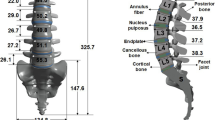Abstract
A non-linear 3-dimensional finite element pediatric lumbar spine model with vertebral growth plate and apophyseal bony ring was developed. Lumbar spondylolysis was simulated in the model. The Von Mises stresses in the structures surrounding the vertebral growth plate, including apophyseal bony ring and osseous endplate were calculated in various loading modes. Instantaneous axis of rotation (IAR) path from flexion to extension was also analyzed. The results were compared with those of the intact model and the literature. The IAR path was at the posterior disc-endplate space of the lower vertebra in the intact spine, and moved cranially towards the upper-posterior disc space in the lytic spine. This was in agreement with in vivo radiological data by Sakamaki et al. [19]. During various loading modes, stresses in the spondylolytic pediatric model were higher than that of the intact model; ranging from 1.1 to 6.0 times, with the highest value in extension at the growth plate. In conclusion, FE models indicate that stress concentrations in the lytic model increase at the growth plate which may lead to physis stress fracture leading to spondylolisthesis.






Similar content being viewed by others
References
Axelsson P, Johnsson R, Stromqvist B (2000) Is there increased intervertebral mobility in isthmic adult spondylolisthesis? A matched comparative study using roentgen stereophotogrammetry. Spine 25:1701–1703
Dandy DJ, Shannon MJ (1971) Lumbosacral subluxation (Group 1 spondylolisthesis). J Bone Joint Surg [Br] 53:578–595
Farfan HE, Osteria V, Lamy C (1976) The mechanical etiology of spondylolysis and spondylolisthesis. Clin Orthop 117:40–55
Fredrickson BE, Baker D, McHolick WJ, et al. (1984) The natural history of spondylolysis and spondylolisthesis. J Bone Joint Surg [Am] 66:699–707
Goel VK, Lim TH, Gwon J, et al. (1991) Effects of rigidity of an internal fixation device. A comprehensive biomechanical investingation. Spine 16(Suppl):S155–S161
Goel VK, Monroe BT, Gilbertson LG, et al. (1995) Interlaminar shear stresses and laminae separation in a disc: Finite element analysis of the L3-4 motion segment subjected to axial compressive loads. Spine 20:689–698
Goel V, Grauer J, Patel T, et al. (2005) Effects of Charite artificial disc on the implanted and adjacent spinal segments mechanics using a hybrid testing protocol. Spine 30:2755–2764
Ikata T, Miyake R, Katoh S, et al. (1996) Pathomechanism of sports-related spondylolisthesis in adolescents: radiographic and magnetic resonance imaging study. Am J Sports Med 24:94–98
Kajiura K, Katoh S, Sairyo K, et al. (2001) Slippage mechanism of pediatric spondylolysis: biomechanical study using immature calf spines. Spine 26:2208–2212
Kong WZ, Goel VK (2003) Ability of the finite element models to predict response of the human spine to sinusoidal vertical vibration. Spine 28:1961–1967
Konz RJ, Goel VK, Grobler LJ, et al. (2001) The pathomechanism of spondylolytic spondylolisthesis in immature primate lumbar spines in vitro and finite element assessments. Spine 26:E38–49
Laurent LE, Einola S (1961) Spondylolisthesis in children and adolescents. Acta Orthop Scand 31:45–64
Mihara H, Onari K, Cheng BC, et al. (2003) The biomechanical effects of spondylolysis and its treatment. Spine 28:235–238
Panjabi MM, Goel VK, Walter SD, Schick S (1982) Errors in the center and angle of rotation of a joint: an experimental study. J Biomech Eng 104:232–237
Sairyo K, Goel VK, Grobler LJ, et al. (1998) The pathomechanism of isthmic lumbar spondylolisthesis. A biomechanical study in immature calf spines. Spine 23:1442–1446
Sairyo K, Katoh S, Ikata T, et al. (2001) Development of spondylolytic olisthesis in adolescents. Spine J 1:171–175
Sairyo K, Katoh S, Sakamaki T, et al. (2004) Slippage occurs following epiphyseal separation in immature spine and its occurrence is unrelated to disc degeneration. Spine 29:524–527
Sairyo K, Biyani A, Goel VK, et al. (2005) Pathomechanism of hypertrophy of ligamentum flavum: A multidisciplinary investigation by clinical, biomechanical, histological and biological assessment. Spine 30:2649–2656
Sakamaki T, Katoh S, Sairyo K (2002) Normal and spondylolytic pediatric spine movements with reference to instantaneous axis of rotation. Spine 27:141–145
Sakamaki T, Sairyo K, Katoh S, et al. (2003) The pathogenesis of slippage and deformity in the pediatric lumbar spine: a radiographic and histologic study using a new rat in vivo model. Spine 28:645–650
Saraste H (1987) Long-term clinical and radiographical follow up of spondylolysisand spondylolisthesis. J Pediatr Orthop 7:931–938
Seitsalo S, Osterman K, Hyvarinen H, et al. (1991) Progression of spondylolisthesis in children and adolescents: a long-term follow-up of 272 patients. Spine 16:417–421
Author information
Authors and Affiliations
Corresponding author
Additional information
Part I of this article can be found at http://dx.doi.org/ 10.1007/s00586-005-1026-z
Rights and permissions
About this article
Cite this article
Sairyo, K., Goel, V.K., Masuda, A. et al. Three dimensional finite element analysis of the pediatric lumbar spine. Part II: biomechanical change as the initiating factor for pediatric isthmic spondylolisthesis at the growth plate. Eur Spine J 15, 930–935 (2006). https://doi.org/10.1007/s00586-005-1033-0
Received:
Revised:
Accepted:
Published:
Issue Date:
DOI: https://doi.org/10.1007/s00586-005-1033-0




